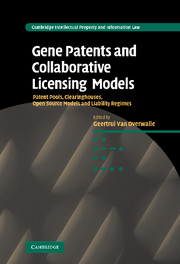 Gene Patents and Collaborative Licensing Models
Gene Patents and Collaborative Licensing Models Book contents
Foreword: Jean-Jacques Cassiman
Published online by Cambridge University Press: 14 January 2010
Summary
At the start of this enticing book, allow me to take you through a few considerations, which may be more philosophical than genetic.
The first thing is to agree on definitions. Indeed, this is more than semantics. If you want to be understood by people from other disciplines you must be sure to speak the same language. To give you an example: the contributions in the present book all deal with ‘patents’. For me as a medical doctor, patent means open as in a patent foramen ovale, a hole in the heart. I understand that in IPR circles, patent also mean open, but did this book not come about in an attempt to keep them patent to access?
Anyway, ‘interdisciplinarity is a type of academic collaboration in which specialists drawn from two or more academic disciplines work together in pursuit of common goals’ (a definition found in Wikipedia). Interdisciplinary programmes may arise from a shared conviction that the traditional disciplines are unable or unwilling to address important problems. They can also arise from new research developments, such as nanotechnology, which cannot be addressed without combining the approaches of two or more disciplines. In our field, bioinformatics is a nice example, since it combines molecular biology with computer science.
Interdisciplinary research should be distinguished from transdisciplinary research. According to the Swiss National research fund, it is intended to make a contribution towards solving socially relevant issues and involves practitioners from beyond the realm of science.
- Type
- Chapter
- Information
- Gene Patents and Collaborative Licensing ModelsPatent Pools, Clearinghouses, Open Source Models and Liability Regimes, pp. xxv - xxviiiPublisher: Cambridge University PressPrint publication year: 2009
